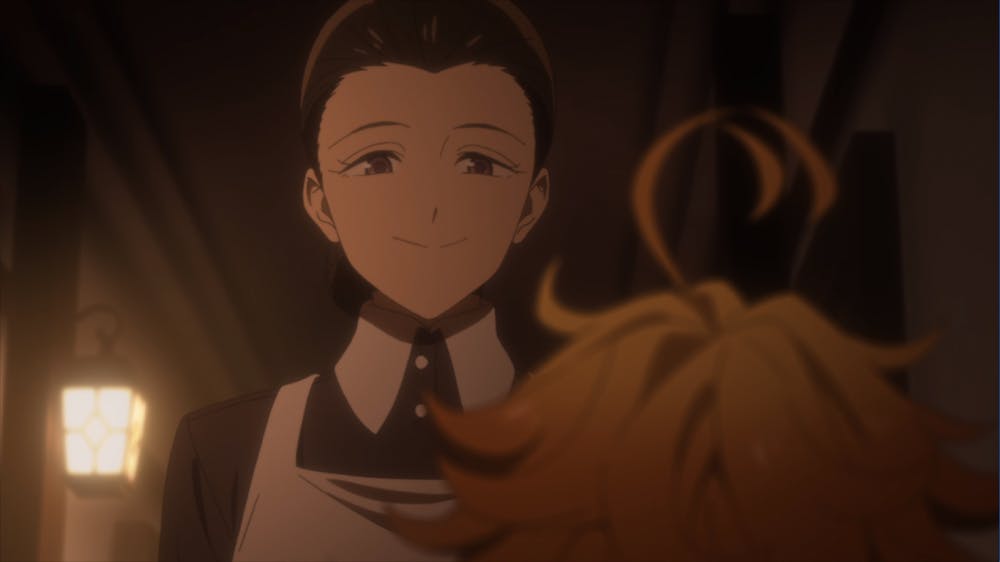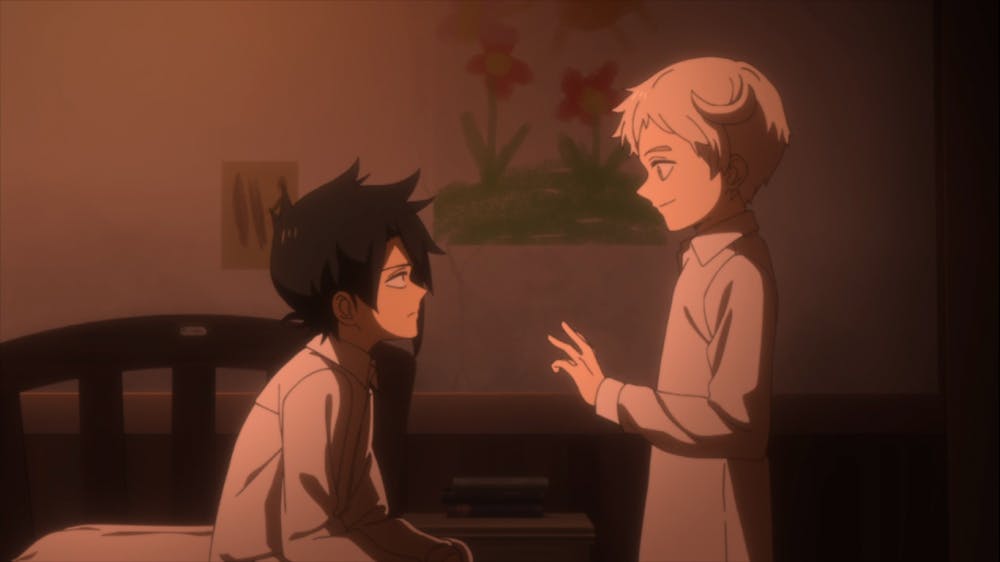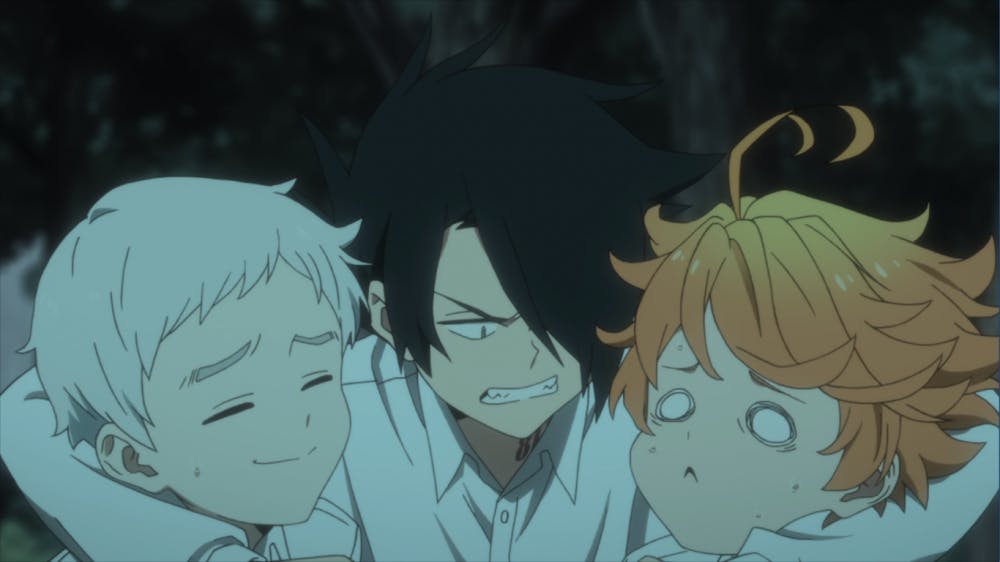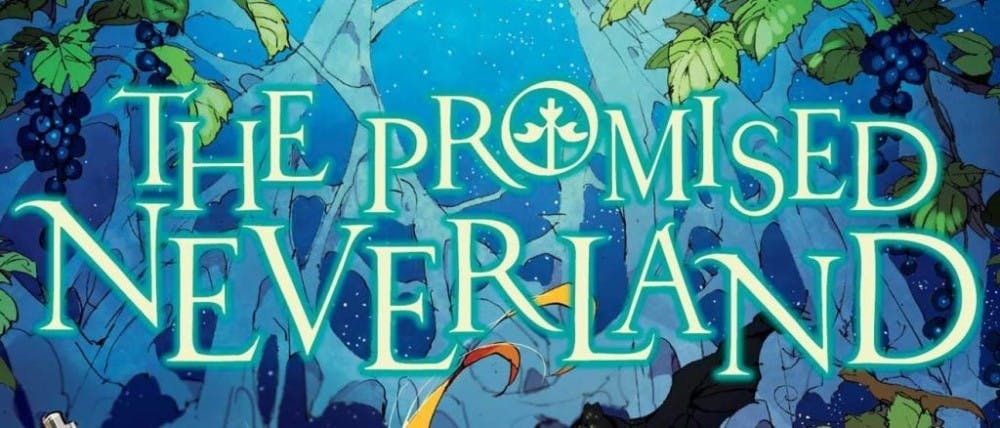2018 was a somewhat disappointing year in anime for me. Despite finally giving me the Vento Aureo anime adaptation I’ve waited so long for, and offering plenty of cute comedy shows, there wasn’t really anything that blew me or the rest of the anime community away, especially when compared to 2017’s standout shows such as Made in Abyss and Land of the Lustrous. However, 2019 seems to be making up for this right out of the gate with The Promised Neverland, a 12-episode anime adaptation of the ongoing Shonen Jump manga of the same name.
The show covers the first arc of the manga and is directed by Mamoru Kanbe of Elfen Lied fame. Unlike its action-heavy Shonen Jump contemporaries, Promised Neverland has more of a focus on horror and mystery elements, not unlike the publication’s other popular thriller series, Death Note. Add this with the anime adaptation airing on the Noitamina block in Japan–which is usually reserved for more experimental adult animation far outside the typical Shonen Jump demographic–and it’s clear to see that this series is quite unique for something that’s aimed at the same target audience as My Hero Academia and One Piece.
A Great Escape
Before describing the basic plot of the series, I’d like to preface that The Promised Neverland is a series best experienced going in knowing as little about the plot as possible. Most plot synopses for anime and manga tend to be pretty vague about the premise, and that’s for good reason, since the story’s main hook is the mystery and finding out where it’s going to go next. However, I can’t critique the show without sharing at least a few plot details. While I won’t be talking about any major story spoilers here, you may want to read with caution if you plan on watching the show yourself and want to get the full impact. I’m also reviewing this show as someone who hasn’t read the original manga, so I won’t be making any comparisons between the source material and adaptation. The anime will be judged on its own merits and not by how well it adapted its source manga.

Image from Crunchyroll
The series takes place at an orphanage named the Grace Field House, where many children live a happy life at the care of their “mother,” Isabella. The children are required to take daily tests to measure their intelligence, but aside from that, they’re allowed to spend their free time however they’d like, as long as they don’t venture out too far away from the orphanage. Curiosity peaked in two of the oldest children, Emma and Norman. They decided to venture out one day to see what lies outside the orphanage. They soon find out that that the orphanage is actually a farm that raises children for the sole purpose of being eaten by demons and Isabella is the one in charge of selling the children off. Now determined to escape their home, the two enlist the help of their friend Ray to free all their siblings and finally see the outside world.
If you’re wondering why the premise sounds bizarrely similar to the 2000 Aardman animated film Chicken Run, that’s because it kinda is. Both feature a female protagonist and a premise about a group of livestock trying to escape from being eaten in a Great Escape-esque plot, so comparisons between the two are neigh inevitable. It certainly doesn’t help that the two antagonists of both stories have very similar character designs, but there’s far more to Promised Neverland than just being a darker version of an animated classic.
If there’s one thing the series absolutely nails, it’s unpredictability. The show has so many twists and turns that it’s difficult to tell where the story’s going to go next. Just when you think you’re able to predict the next big twist, something else comes out of left field and throws you for a loop. A majority of the series is spent on the children trying to execute their escape plan, which in itself is entertaining to watch due to the clever ways the cast goes about fulfilling their goals. It’s very similar to Death Note in that there’s a lot of mind games at play and instead of focusing on hand-to-hand combat like a lot of action manga, it instead focuses on a battle of wits. Most of the tension comes from seeing how the cast will outsmart the antagonists or get out of a seemingly impossible predicament, which is great as someone who absolutely loves tense thriller stories and finds them criminally underutilized in anime and manga.
A wonderful group of precious children
Of course, you can’t have a good plot without a likable cast of characters, and luckily Promised Neverland has an incredibly solid cast. The three main characters; Emma, Norman, and Ray, are each great in their own right and receive an ample amount of development throughout the series. Even though Emma may come across as a typical, ditzy, optimistic shonen protagonist at first, and not as cunning as Norman or Ray, she really matures as the series progresses and even starts to prove that she’s just as resourceful as her peers by the end of the show. My personal favorite of the main cast is Ray, as he has the most fleshed out backstory of the three and goes through the most interesting developments. Even though I found Norman to be the least interesting out of the three, he is the main source of the series’ escape plans and it’s still entertaining to see what he’s able to come up with.

Image from Crunchyroll
Although not as deep as the main cast, the side characters are also endearing in their own right and you end up rooting for them to escape. The main antagonist of the series, Isabella, is also a surprisingly well-rounded antagonist. Despite initially coming across as a one-dimensional villain, it’s eventually revealed that there’s more to her motives than initially thought, and by the end of the season I ended up somewhat sympathizing with her.
If there’s one issue I had with the characterization, it’s that I wish there was a little bit more time exploring the relationships between the cast and how they ended up affecting the overall plot. From what I’ve heard, this was something that the anime ended up glossing over due to its limited run time, and the manga did a better job giving context to how the characters motives relate to one another in the grand scheme of things. Even though I haven’t read the manga, it’s easy to see where some much-needed characterization moments were cut and how the first season would have benefited from an extra episode or two of runtime. Still, that doesn’t change how great the main cast is overall and I can’t wait to see how they develop by the next season.
The CloverWorks redemption
The series is animated by CloverWorks Inc., a former animation studio of A-1 Pictures, established in April 2018. It became its own separate entity in October of that year. Since the studio has only been around for less than a year, their portfolio is rather minimal and mainly consists of A-1 hand-me-downs such as Persona 5: The Animation and the second half of Darling in the FranXX, neither of which inspire confidence in the studio’s work. Especially not Persona 5 with it’s… let’s just say less than stellar animation. Luckily, Promised Neverland doesn’t fall victim to many of the shortcomings of the studio’s other works, thanks to it being a high-profile project that wasn’t pushed onto the production team last minute.

Image from Crunchyroll
Not only is the animation consistent throughout the entire show, but there’s some nice dynamic cinematography that helps the show stand out visually compared to A-1’s usual cookie-cutter animation. On the subject of A-1, the varied character designs from the source material carry over well into the anime. They help the series not suffer from the dreaded “same-face syndrome” that plague a lot of A-1 shows, most notably Sword Art Online and their other light-novel adaptations. The only minor nitpick I had with the visuals was that some of the characters’ faces are a bit to small compared to their heads, but that was something I got over fast.
Visuals aside, The Promised Neverland’s soundtrack is absolutely stellar. The original soundtrack was composed by Toshiya Ono, who is best known for his work on Land of the Lustrous and Gatchaman Crowds, both of which also had phenomenal OSTs, and his talent certainly shows in Neverland’s OST as well. Not only does each piece do an excellent job at setting the tone and atmosphere of each scene, but they’re also fantastic songs on their own. Some of my personal favorites include the melancholic, yet inspiring main theme, the energetic and jazzy “Escape Theme.” There’s also “Isabella’s Lullaby,” which is an incredibly emotional song that is especially impactful in its use in the season finale. Very rarely will I like an anime’s soundtrack enough to listen to it in my spare time, but I found myself using Promised Neverland’s OST as the soundtrack of my writing sessions plenty of times since watching the show, this review included.
The only complaint I have with the music is in one particular scene, in the latter half of the series, where the music clashed with what should’ve been an emotional scene. Without going too deep into spoilers, it was an irritating stylistic choice that completely robbed that scene of any emotional impact it would’ve had otherwise. Despite being a small gripe in the grand scheme of things, that moment in particular is still a pretty noticeable blemish on an otherwise fantastic show.

Images: Crunchyroll
Featured Image: Amazon
For more entertainment related content, visit us at Byte BSU!




















